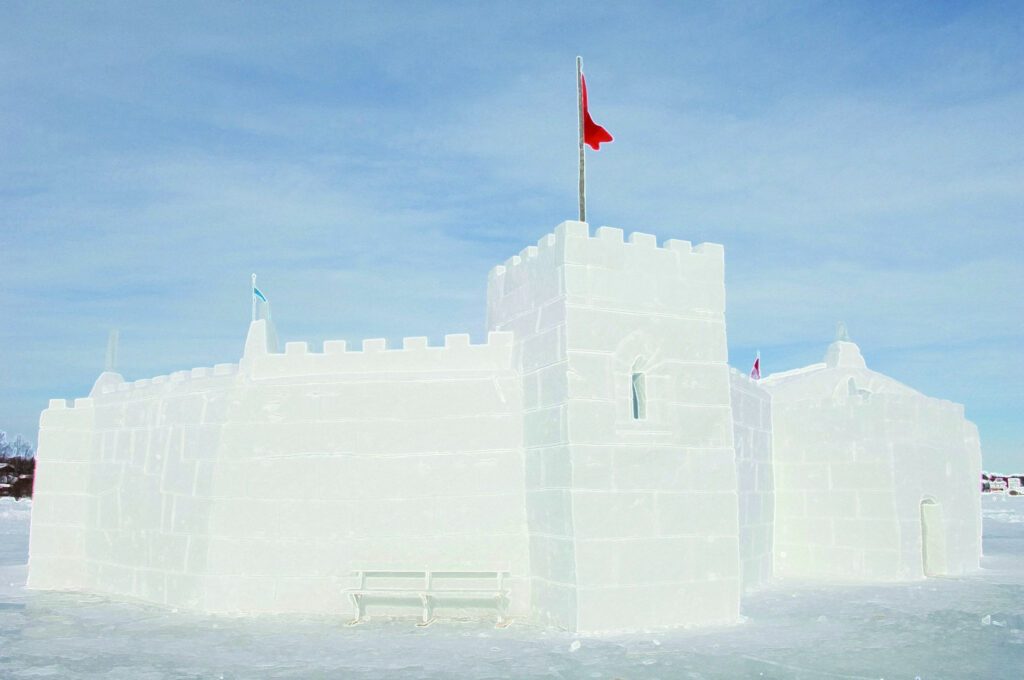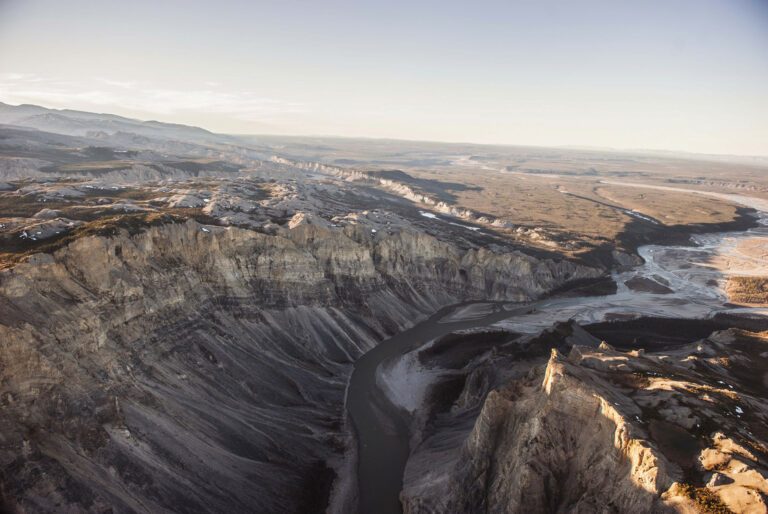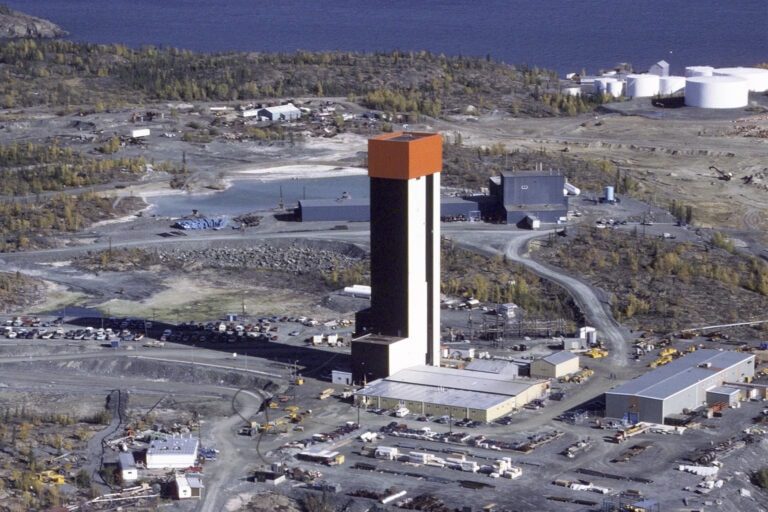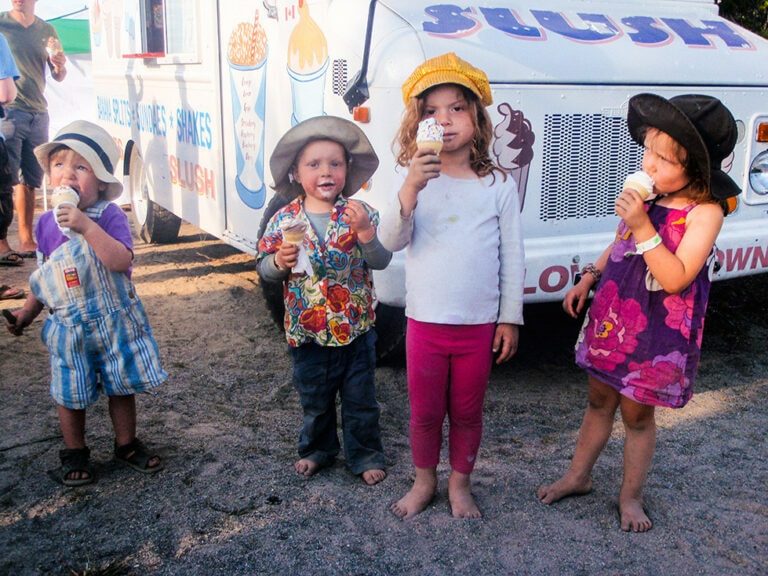As the XXI Snowking Festival kicks into full gear this week, take a look back at this history of the event, first published a year ago:
It all starts in the Woodyard, that picaresque, old-by-Yellowknife-standards neighbourhood on the shores of Yellowknife Bay. Its buildings are examples of a genre you could call survival architecture: cozy, pie-eyed shacks and glorified lean-tos and slightly modified piles of lumber and mechanical parts, created by men and women without much in the way of goods, or technique, or loftier dreams than a warm space to crawl into at -40. But what the original builders of the Woodyard may have lacked in architectural finesse, or sobriety, they made up for with ingenuity and originality.
Here, in the winter of 1992-93, the Snowking (then still known to most folks as Anthony Foliot), a house builder who ended up in Yellowknife after working his way through places like Lutsel K’e, Deline, and Wrigley, went out to play in the snow with his kids:
“The City wouldn’t plow the Woodyard,” says the Snowking today, looking back. “So buddy — Scott Mitchell, also known as Sir Shivering Sam — had a quad with a little plow attachment on it, so he kind of plowed the Woodyard and made a big pile. My kids and his kids were the same age, outside playing snow fort. They were just little kids, right, and they didn’t know what they were doing. They were just sort of climbing the hill and digging a little bit of a hollow and sliding and stuff. So we went out to play with them, cause we were into that kinda stuff.”
The deeper they got into the snow, the deeper the Snowking and Sir Shivering Sam got caught up in what they were, on a whim, building. The kids eventually got cold, tired, and a little bored. They headed inside to watch TV. Not the Snowking and Sir Shivering Sam: “We kept on going, and made them a really nice fort. An oversized quinzee [a very simple type of snow shelter made by digging into a mound of snow]. So that was the first, sorta like, snow fort.”
And that’s the origin of the Snowking, the Snowcastle and the Snowking Winter Festival: a couple of grown men, playing like children in a snowdrift one chilly afternoon in the Woodyard.
By the following year, the Snowking was out of the Woodyard, living on the water in a houseboat, but he hadn’t forgotten that first, crude quinzee, and the way neighbourhood kids had spent the winter crawling all overit, having the time of their lives.
“So I started building something for the kids on the water,” he says, though the process was pretty laborious before they had a routine worked out. “We would go way over [on the ice] where there’s hard-packed snow, and we would cut some snow blocks, and qamatiq them back, and then we’d go way over here, and so, that was kinda labour-intensive and we weren’t really getting uniform-sized blocks.”
First breakthrough
Then came the Snowcastle’s first major technological breakthrough: “Shivering Sam, he had access to a front-end loader ‘cause he worked for the government, and so he piled up snow, kind of like a big, long snow berm, and we used to cut our snow blocks out of that and that gets really hard, because the snow settles and it turns into concrete — ‘snowcrete’ or whatever.”
It was a step forward, but the resulting castles remained relatively unsophisticated. “It was really old-school,” says the Snowking. “Blocks of all sizes. We would kind of have like a jumble wall, and not really any sense of construction.”
As for the festival that began to grow around the castle, you can, indirectly, thank Mrs. Snowking for that.
“I think it was about the third year after I was working on the ice, and the wife said, ‘Are you gonna just play in the snow all winter or what?’ and I said ‘Oh nooo, honey, I’m putting up a festival!’ Trying to justify it, y’know, cause I did want to keep playing in the snow. So then we had a festival and we had a whole bunch of little kids acting, and that was pretty fun.”
The first Snowking Winter Festival was a homespun, family-driven affair, mainly by and for Old Town residents, but every year, like the castle itself, the event grew in size and scope.
“It just started to get progressively bigger over the first 10 years,” says the Snowking. But while the festival expanded, the castle-building technology had plateaued, and the building crew — especially the Snowking himself — was starting to get tired of all that quarrying and semi-haphazard block-piling. It was a complicated process, climbing up the snow berm and cutting it into usable blocks, and the resulting overflow of unusable half blocks and bits and pieces “ended up in the yard like a bunch of dolmens or menhirs or whatever you want to call them.”
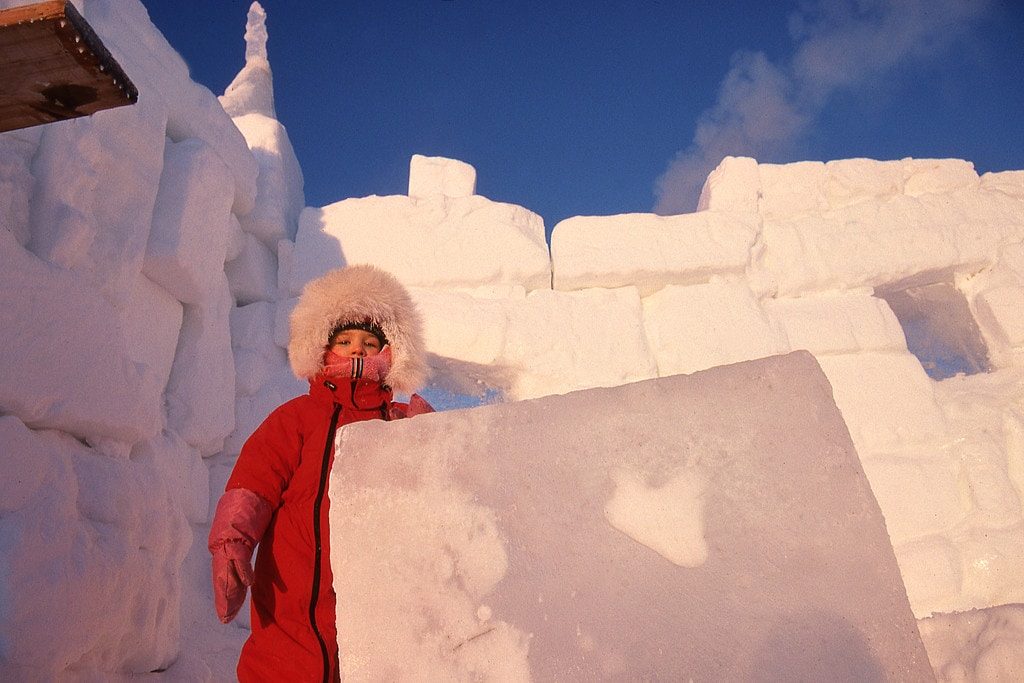
Photographer Fran Hurcomb’s daughter Kathleen at Snowking I in 1995. Photo courtesy of Fran Hurcomb.
Around the ninth anniversary came the next Great Leap Forward in Snowcastle technology.
“Shivering Sam said ‘Why don’t we just pour it?’” recalls the Snowking. “Just pour the snow into a form. You’re pushing it along, pushing it along and then you lift it up and drop it on itself, you lift it up and drop it on itself, and you’ve got a big pile there and it’s all been altered, like an avalanche.” That’s the trick, he points out: putting the snow through a vortex of constant action and flux in an attempt to change its nature from innocuous white stuff to serious building material.
“The molecules of the snow have to be altered,” he says. “You can’t just make an igloo out of puffy fluffy snow, as you know. It has to be a specific kind of snow, that’s been blowing across the snow and collects. So for the Snowking IX, we started blowing the snow into form boxes. Blowing it, blowing, blowing it forward until you get it into the form box, and then you pop the box — it’s just a sheet of plywood here and a sheet of plywood here — and then you’ve got right angles, and it’s four feet high, and you can cut uniform blocks.”
Joe Snow, Snowcastle XX construction leader and the longest-serving construction crew member aside from the Snowking himself, was there for the transition from building with blocks of snow to pouring forms. Joe, also known as Ryan McCord, recalls when the castle didn’t even have a lid on it. ”I can remember sitting there for the Frozen Dog Film Festival with no roof on. Everyone just sat there on the ground, and it was snowing, and we all got up after a few films covered in about two inches of snow.” He laughs. “The performances back then, there was maybe a little bit of heat but it was cold in there.”
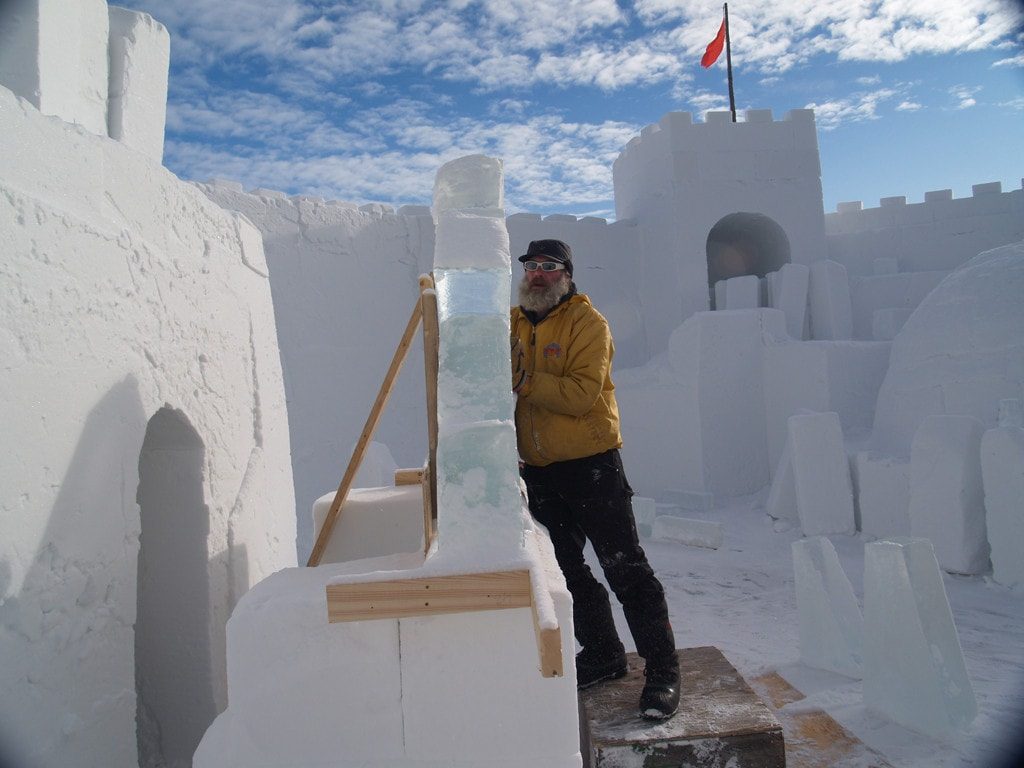
At the XVI festival. Photo courtesy Stephan Folkers.
Building crew member the Avalanche Kid, also known as Joel Maillet, has tracked the evolution of Snowcastle building techniques, along with the development of the festival. “I watched a documentary on the making of an ice hotel in Sweden about two years ago, and realized that a lot of our techniques are very much in line with theirs, just naturally. Fifteen years ago, the Snowking could have decided to take on all of their techniques and approaches and formmaking, and built a castle along their lines. But instead we took this long, meandering, evolutionary road that basically took us to a very similar spot, which is reassuring. It tells us that we’re in line.”
“We evolve year to year,” the Avalanche Kid continues, “always building on our knowledge from the last year. It truly is traditional knowledge, spanning years. We started working with snow-blocks and understanding what they can do, we started working with forms, experimented with them. There were a few poor designs, but there have never been any accidents, never any cave-ins of any sort. We’ve had some gross, slumpy ceilings, but we’ve refined our formwork to better suit the snow and how it settles and takes shape.”
Joe Snow has watched the festival’s audience grow along with the castle. Those days 10 years ago, the film festival might have gathered 15 to 30 people tops, while the Royal Ball brought in around 50 to 80. “Nowadays at some of our events we’re having 250-plus. So you can see how the castle has become so much more established and such a cultural event.”
A lot of that growth has to do with a crisis that hit right around the time of Snowking Winter Festival XV. The Snowking, by his own admission, was on the ropes after a decade-and-a-half of playing in the snow and the resulting complexities of an increasingly popular event. “After XV, there was a major breakdown. I was accused of not being a smart businessman. Okay. I stand accused, guilty as charged. There was no festival director, nobody fundraising and talking to the bureaucrats. I’d lost my patience. I was just too coarse and rough around the edges.”
Enter Frida Frost
The semi-crisis was solved by Frida Frost, also known as Erika Nyyssonen, now in her fifth year as festival director. ”She’s really brought us a long ways in terms of credibility,” says the Snowking.
Frida didn’t have any plans, or festival planning experience, when the Snowking asked her to join up as ringmaster. The year before she joined as director, “there wasn’t a lot of childrens’ programming, so I wrote a play and my friends performed in it. It was called Oddy the Hare. It was about Arctic Hares.”
“The fifth year of the castle was when it actually became the festival,” she says. “They did plays and puppet shows. There were some bands.” Since taking over, Frida has made it her mission to broaden the scope and scale of festival programming, pushing it forward every time: “Each year I’m like ‘Okay, let’s do a little bit more. What can we do?’” There’s a roster of popular regular events every year, like the Royal Ball, a fiddler-led dance, and the Royal Rave, hosted by the Bushleague DJs, plus a regular art installation put on by Down to Earth Gallery called Iceolation. “And this year and last year, we put out a call for performers and artists and had a deadline, and we hadn’t really done that before. People had just approached along the way. But we actually had quite a few people from outside of Yellowknife apply this year, and we’re able to bring quite a few of them in, so that’ll be cool.”

The quarry at Snowking X in 2005. Photo courtesy Stephan Folkers.
Says crew member Lady Icicle, also known as Myka Jones, “[Frida] has poured her heart and soul into the festival, and she has brought some amazing line-ups to town. As a result of that we’ve seen a much greater diversity of people coming to the castle.”
Lady Icicle herself was responsible for the next evolution of the castle. Those first form-work buildings got larger every year, but remained utilitarian in design. “They were factory-like,” says the Snowking, “with just square windows. Nothing fancy.” Until five years ago.
“One year, this pretty little girl came in, and she wanted to be a volunteer,” says the Snowking. “So I said ‘Snow-cadet Jones, what do you want to do?’ And she said, ‘Well, I don’t know. What do you want me to do?’ In those days I had some Katimavik volunteers, and they would render brick marks and that kind of stuff, carve lines to make it appear like it was made of bricks. I said ‘Wanna try that?’ and she got up on a scaffold and outworked these two fellows from Katimavik big time, eh? So I said ‘Okay, you’re too advanced for that, so come on down here and how would you like to try windows?’ ‘Okay.’ So I let her go on a window wall and I came back two hours later, and she’d done a wonderful art deco deal on there. It was beautiful. Perfect. I said ‘Oh, okay, very good. You ever tried any 3D?’ I gave her a block of snow and she carved gargoyles, beautiful gargoyles. So then I said ‘Okay, Snow Cadet Jones, I got bad news for ya.’ ‘What’s that?’ she said, all sad. I said ‘You can’t be a volunteer anymore.’ And her shoulders sagged and she was all crestfallen. ‘Why not?’ ‘Cuz you’re on the crew now, here’s your first paycheck.’ And she got a snow name — from Snow Cadet to Lady Icicle.”

Snowking XIII in 2003. Photo courtesy Fran Hurcomb.
Since Lady Icicle’s arrival, the days of the utilitarian castle have gone forever. A newcomer with a background in art and graphic design, Lady Icicle quickly realized that her skills almost directly transferred to working in the medium of snow. “One of the first creative jobs [the Snowking] gave me was to do a frieze to decorate the top section of a snow wall. This big triangle. And he said ‘I don’t know, put a snowman in there or something.’ And I didn’t really stop at that.”
“Once I’d started, it was a very intuitive process,” she says. “It just became fun, composing these pictures and scenes in the snow, and I just loved being outdoors and physically working.” Lady Icicle’s own art is somewhat abstract, but being at the castle site “and seeing the people that were coming and playing there and interested in it, sort of inspired me to tell more human stories, or represent things that people could relate to, in a sense.”
Artistic approach spread
Lady Icicle’s artistic approach has spread throughout most of the crew. “Perhaps after I got involved and started experimenting with my own interests it maybe encouraged other people on the crew to start experimenting as well in different ways that they may never have thought of before.”
“It’s great to have a place to play with snow and ice and ideas.”
“It used to be like a boy’s club,” says the Snowking, “and we’d all drink beer and play in the snow, but it’s like there’s this whole gang of girls that descended upon us and what they’re doing is really nice. We got baked goodies in the coffee shop, and the language has really cleaned up. It was actually a really positive thing.”
Now that the Snowking Winter Festival has reached the ripe old age of 20, does the Snowking think about hanging up his crown?
“I can’t stop. The children wouldn’t be happy at all. There’s many generations that have passed through the castle. One of the funniest things I’ve heard is that there was a young girl who walked into the castle with a baby in her arms, and her boyfriend, and she turns to the guy and says “My dad used to bring me here when I was a kid.” So now those kids who used to come through here 20 years ago are bringing their kids. There are some kids that come here every year. And the local ones, they bring me cookies, because they know that’s how you can maybe get a sneak peek before the doors open. There’s this little kid, Charles. I said ‘Charles, looks like I need a slide tester before the castle opens. You up for it? And he’s like ‘Oh yeah, oh yeah, Snowking!’. Three days later I’m at a birthday party for one of his little friends there, and Kieran comes up, another five-year-old, and he goes ‘Snowking, can I be one of the guys that tests the slide before the castle opens, too?’ And I’m like ‘Oh, you’ve been talking to Charles.’ Those little kids, they’ve been growing up on that kind of stuff. Even before they’re walking, talking, they know they’ve been there. That’s what drives me.”

Snowking and crew from left to right, Regan Fielding, Stacey Campbell, and Ryan McCord at the HQ in 2005. Photo courtesy Stephan Folkers.

Kids at the castle, Snowking IV in 1998. Photo courtesy Fran Hurcomb.

Snowking during a local contest held during XI in 2006. Photo courtesy Stephan Folkers.

Musician Mike Bryant roucking out during XIV in 2009. Photo courtesy Stephan Folkers.

